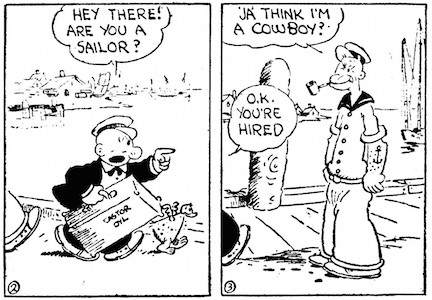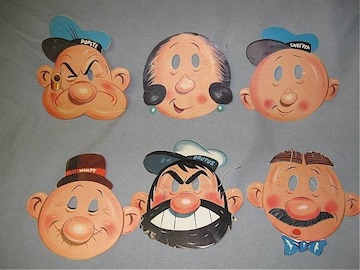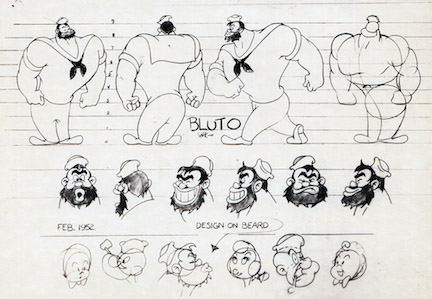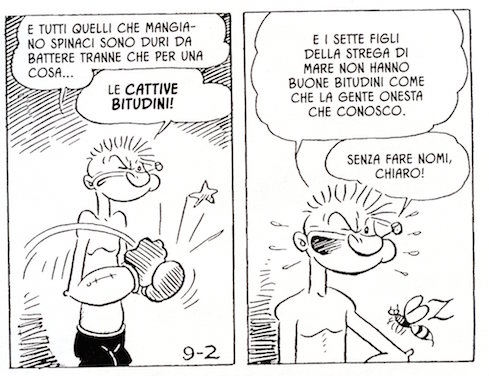|
Entertainment Magazine: Film: Cartoons: Popeye Blow Me Down! Ninety Years of Popeye!Watch and Download FREE Popeye CartoonsBy Fred M. Grandinetti Popeye the Sailor turned 90 on January 17, 2019. He was originally created by E.C. Segar for his Thimble Theatre comic strip. Segar was born on December 8, 1894 and raised in Chester, Illinois. At the age of 18 he decided to become a cartoonist and took a correspondence course from W.L. Evans from Cleveland, Ohio.
Popeye the Sailor (1933) He eventually moved to Chicago and met Richard F. Outcault, the creator of The Yellow Kid. Outcault introduced him to The Chicago Herald. Segar’s first comic strip was Charlie Chaplin’s Comedy Capers which ran a little over a year. Eventually Segar worked for King Features Syndicate and created Thimble Theatre for The New York Journal in 1919. The strip’s original leads were Olive Oyl, her scheming brother, Castor and Ham Gravy. This trio headlined the strip for about a decade.
E.C. Segar's first drawing of Popeye published on January 17, 1929. On January 17, 1929 Castor needed a navigator for his trip to Dice Island and came across an odd looking fellow. When Castor asked the man if he was a sailor his reply was “ja think I’m a cowboy?” Popeye was intended for only one story but the newspaper reading public fell in love with the pipe smoking sailor man and he was quickly reinstated. Popeye was a character who didn’t take any guff from anyone and had super human strength long before Superman put on his tights. Segar based Popeye on Chester, Illinois resident Frank ‘Rocky’ Fiegel. He was a pipe smoking man with a penchant for fistfights. Dora Paskel was an unusually tall and thin woman who wore her hair in a bun like Popeye’s beloved Olive Oyl. William Schuchert, a theater owner, loved hamburgers and was the inspiration for moocher, J. Wellington Wimpy. Segar created memorable characters for the comic strip including; The Sea Hag, Alice the Goon (who gave children nightmares), Eugene the Jeep and Popeye’s father Poopdeck Pappy. By the early 1930’s Popeye products lined store shelves. These same items have become highly priced collectibles today. Although Segar passed away in 1938, he is still regarded as one of the most influential and talented cartoonists of all time. He was among the first to combine humor into long running adventures. It was certainly difficult to top Segar’s work but his successors kept the strip going adding their own creations. Successors to the strip were Doc Winner, Tom Sims, Bela Zaboly, Ralph Stein, Bud Sagendorf and Bobby London. Today a new Sunday strip is produced by veteran cartoonist Hy Eisman. It can be seen at http://comicskingdom.com/popeye Despite his success in newspapers Popeye’s career as an animated cartoon character is where he continues to be best known to audiences. In 1933 Max Fleischer put Popeye, Olive Oyl and Bluto in one of his Betty Boop films. The cartoon was a huge success and the sailor’s own series began shortly thereafter. In the comic strip Popeye rarely ate spinach but Fleischer made this a staple of the animated films. By 1938 polls showed the Fleischer Popeye cartoons were more popular than Disney’s Mickey Mouse. Beginning in 1942 Famous Studios took control of producing the animated cartoons where they continued to remain a top box office attraction. The theatrical series concluded in 1957 when the majority of the sailor’s celluloid antics were sold for television distribution. The success of the theatrical cartoon series had a lot to due with the talented individuals who supplied the voices for Popeye (William Costello and Jack Mercer), Olive Oyl (Mae Questel and Margie Hines) and Bluto (Gus Wickie and Jackson Beck). Mercer’s mumblings, as Popeye, are remembered by audiences to this day. Mercer would also provide the voices for Poopdeck Pappy, Popeye's nephews and J. Wellington Wimpy. Questel eventually handled the vocals for charming baby Swee'pea and the wicked Sea Hag!
1962 Popeye Masks by Jaymar. When the theatrical cartoons produced by Fleischer and Famous Studios debuted on television in September of 1956 Popeye mania swept the country. Hundreds of new Popeye products were produced. King Features Syndicate created a television division and churned out 220 cartoons made for the small screen. This was in addition to the 234 theatrical films which continued to air on many local stations hosted by an adult. Nearly every television station had a live host introducing Popeye cartoons capturing huge ratings. For example, in New Hampshire, Uncle Gus aired Popeye cartoons for several years. He would introduce the sailor by cranking his Popeye jack in the box. In the King Features Television cartoons Popeye’s bearded foe was no longer Bluto but called Brutus. Paramount Pictures, who financed the theatrical cartoons, informed King Features Bluto was a creation of the Fleischer Studios. However, Bluto made his debut in Segar’s comic strip in 1932 thus under King Features’ ownership. No one bothered to due proper research and Brutus was born.
A model sheet for Bluto, from Famous Studios, used in the production of Child Sockology (1952). Beginning in 1978 and airing until 1984 CBS aired new Popeye cartoons produced by Hanna-Barbera for CBS. Despite being non- violent, due to network practices, the cartoons were a big hit. In 1980 Robin Williams starred as the sailor in the feature film, Popeye, which did not bomb at the box office as many have speculated over the years. There have been other attempts of bringing Popeye back to the small screen including Hanna-Barbera’s Popeye and Son and a CGI adventure which aired during his 75th anniversary. Cartoon Network’s The Popeye Show was the most successful as this anthology series aired the theatrical cartoons restored as they appeared in theaters. The sailor and his crew are not only popular in the United States but all over the world. In Italy, for example, hundreds of original comic books have been published. In Europe the Thimble Theatre comic strip continues to be reprinted where Popeye is known as Braccio Di Ferro. Today Popeye has a highly successful Facebook page managed by King Features Syndicate located at https://www.facebook.com/Popeye/. A preschool version of the sailor and his pals is in production introducing him to a young audience. Warner Home Video recently released a DVD of his early color films produced by Famous Studios.
Popeye contemplates, having bad habits, will be his opponent’s downfall in the ring despite their consumption of spinach. From September 2, 1940 by Tom Sims and Bela Zaboly. On a more personal level I have donated Popeye cartoons to various children’s hospitals and hospices for several years where he acts as a “strength figure”. The sailor man is much more than a guy who downs spinach to bop assorted bearded brutes. In print Popeye would often stop a battle to remind an opponent that, despite his size, he can’t win because of corrupt values. On film several hundred of his cartoons would conclude with Popeye singing a song with lyrics featuring an important lesson. Happy 90th birthday Popeye! Break out the spinach juice. Popeye Books By Fred Grandinetti
Popeye: An Illustrated Cultural History
|
.jpg)



